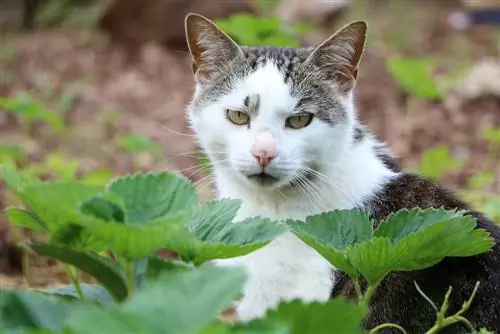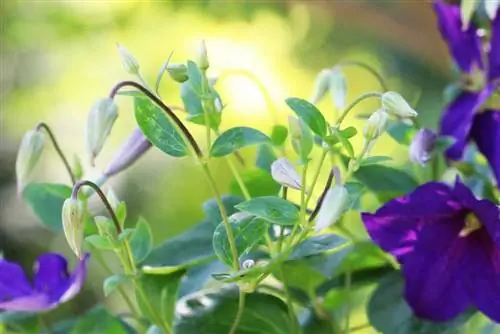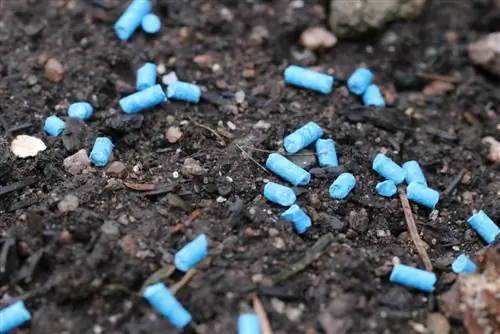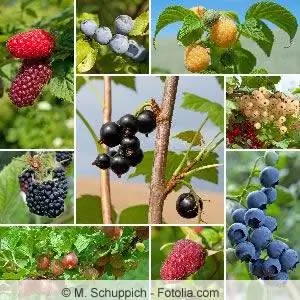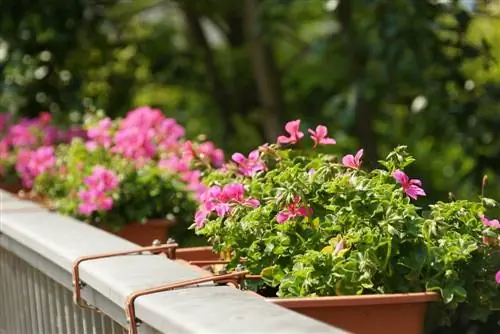- Author admin [email protected].
- Public 2023-12-17 03:39.
- Last modified 2025-01-24 12:45.
Perhaps your cat's mysterious stomach upset has just given you a huge fright, perhaps a new home is to be set up for humans, a young cat and soon to be a baby - there are households in which poisonous plants are best left outside from the start. Even though many of our common ornamental plants are poisonous, you can create a wonderfully green home without critical substances: In addition to the usual range of houseplants, there is a large selection of non-toxic plants available for rooms, balconies and gardens. Some of these plants not only offer decoration, but also real utility value, for cats and humans:
Profile
- Most houseplants and many balcony and garden plants are foreign exotics
- This makes them dangerous for cats who nibble on plants
- No plants are safe from some cats because the cats are “bored to death”
- But even busy cats like to eat plants
- They should, because the plant material helps with digestion
- A mother cat cannot prepare her offspring for exotic imported plants
- Only cat owners who ban poisonous plants from the environment have a relaxed life
- This does not exclude a green environment because there are many plants that are non-toxic to cats
- Which are just as non-toxic to humans, the baby can also discover more in the poison-free house
- With the right plants there is even a harvest for humans and cats
Plants that are non-toxic for cats
are available for every purpose and location:

Houseplants
- Date palm, Phoenix dactylifera
- Thickleaf, Crassula
- Fringe bag, Crossandra
- Kentia palm, Howea
- Coconut palm, Cocos nucifera
- Basket Marante, Calathea
- Creeping beautiful cushion, Callisia repens
- Orchid Catleya, Catleya
- Orchid moth, Phalaenopsis
- Orchid Tiger, Oncidium
- Orchid Vanda-, Vanda
- Orchid, Tongue, Odontoglossum
- Pennigbaum, Crassula ovata
- Shamflower, Aeschynanthus
- Skewed plate, Achimenes
- Beautiful mallows, abutilon
- Sword fern, Nephrolepis ex altata
- African Violet, Saintpaulia ionantha
- Christmas cactus, Schlumbergera
- Indoor maple, abutilon
- Carpenter fir, Araucaria heterophylla
Balcony and potted plants
- Fuchsia, Fuchsia
- Bluebells, Campanula
- Heather, Erica
- Camellia, Camellia japonica
- Losbaum, Clerodendrum bungei
- Slipper flower, Calceolaria
- Glory flower, Clerodendrum bungei
Garden Plants
- Bentgrass, Agrostis stolonifera
- Foxtail grass, Alopecurus
- Heather, Erica
- Jasmine, winter, Jasminum nudiflorum
- Catnip, Hybrid, Nepeta faassenii
- Timothy grass, Phleum pratense
- Roses and all rose-like species
- Mallow, mallows, the whole genus
- Sage, Salvia officinalis
- Pansies, Viola wittrockiana
- Marigold, marigolds
- Thyme, thymus
- Star moss, Sagina subulata
Tip:
Not only plant poisons, but also fertilizers and chemical treatment e.g. B. with pesticides can kill the cat. So be careful with freshly purchased plants, anything that doesn't come from a gardener you trust should be out of the reach of the cat.
Non-toxic plants with added value for cats and humans
If you protect yourself, pets and small children from accidentally falling victim to any poisons in your home environment by choosing plants carefully, that is certainly a good thing. But you can also go one step further and equip your household with plants that bring real benefits to people and animals. Such plants also come in a wide variety, with very different uses:
Cat grass
" Cat grass" is a must in a human-cat apartment, not only because it protects other house plants from being eaten or eaten by the house cat: cats living in the wild "graze" outside, serve thoroughly eat the free-growing grass and eat it up. According to popular belief, they do this to make it easier to regurgitate the indigestible hairballs (bezoars) that form in the digestive tract after grooming (or eating prey). If these hairs clump together in the gastrointestinal tract, in the worst case scenario it can cause an intestinal obstruction. Other scientists suspect culinary motives or the attempt to absorb nutrients from plant components or see eating grass as an expression of boredom, but scientific evidence for these theses is still lacking.
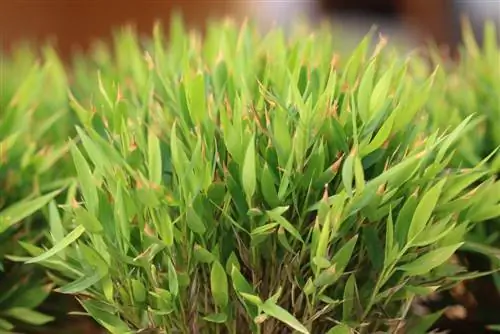
Very different grasses are used and recommended as cat grass, here is a brief overview:
- Various grain shoots such as barley, oats, millet, rye, wheat germ grass
- People can also help themselves here, for muesli, salad, green smoothie
- Various Cyprus grasses, e.g. B. Cyperus involucratus (often incorrectly traded as C. alternifolius, popular compact cultivar 'Nana')
- Fresh green cyper grass (C. eragrostis), tall cyper grass (C. longus, wild galangal), real papyrus (C. papyrus) are also suitable
- The frequently recommended Cyprus grass Cyperus zumula is not the best choice as cat grass, but is very hard and sometimes very sharp
- If the cat (as usual) swallows the blades of grass whole in order to later regurgitate them, the esophagus can be dangerously injured
- An interesting alternative is the tiger nut, Cyperus esculentus, which produces delicious almond-like fruits for humans in the soil
- Most cats love C. esculentus, even those that can't tolerate regular cat grass
- Similarly interesting is nut grass, Cyperus rotundus: cat grass for cats, runner tubers with a hazelnut-like taste for their humans
- Bamboo is also a grass and suitable as cat grass, some cats love it, some it is too hard
- The Seychelles grass “Pogonatherum paniceum”, known as indoor bamboo, should be kept away from cats because of its sharp edges
Tip:
There are further dangers lurking when choosing cat grass: If the existing spider plant is also to be used as cat grass (as is sometimes recommended), that's not such a good idea: The powerful air freshener Chlorophytum comosum filters out various pollutants Indoor air and pollutant filters do not belong “in the cat”. The lawn in front of the front door can poison cats if it is infected by fungi (e.g. perennial ryegrass Lolium perenne, mushroom Neotyphodium lolii with toxic Lolitrem B, but this occurs quite rarely).
More valuable plants for cats and humans
There are recognized cat herbs that people also enjoy, and recognized human medicinal plants that are also good for cats. The following are non-toxic plants for cats and humans (for rooms, balconies, pots and gardens) that can do more than clean cats' stomachs:
- Field mint, Mentha arvensis, which cats like to snack on, can be used by humans like peppermint
- Bulrush, Juncus, pond and house plant from which you can weave baskets
- Real valerian, Valeriana officinalis, attracts cats with the alkaloid actinidine, tea from the root soothes the cat owner and his stomach
- Real thyme, Thymus vulgaris: Kassler with honey-thyme crust, beef bourguignon, piperade
- Field thyme, Thymus pulegioides, usable like normal thyme + medical talents
- Maidenhair fern, Adiantum capillus-veneris, indoor medicinal plant against colds + hoarseness
- Geranium, pelargonium, various rose and scented pelargoniums can be used to flavor drinks and sweet fruit preserves
- Bluebells, Campanula, flowers of all Central European species can be used as edible decorations, young shoots can be used as asparagus, leaves can be used as salad
- Golden balm, Monarda didyma, humans and cats can eat the leaves fresh and cooked, people also flavor desserts with the leaves or drink them as tea
- Houseleek, Sempervivum, provides support for cats' paws on walls and roofs and is said to bring luck to human homeowners.
- Hibiscus, Hibiscus rosa-sinensis, roots, leaves, flowers can be eaten raw or cooked
- Jasmine, real, Jasminum officiale, can be used as jasmine tea and fragrance oil
- Bald Triplet Flower, Bougainvillea glabra, climbs several meters up its support in one season
- Nasturtium, Tropaeolum majus, can be used in the kitchen and as an indoor medicinal plant, medicinal plant of the year 2013
- Cat gamander, Teucrium marum, insider tip for cats and people who enjoy culinary discovery
- Real catnip, Nepeta cataria, when dried makes every cat toy interesting (again), people drink catnip tea for colds, upset stomachs and more
- Creeping Jacob's ladder, Polemonium reptans, attracts cats with the smell of valerian and people with high decorative value and healing properties
- Lavender, Lavendula augustifolia, every animal and every person likes it
- Marjoram, Origanum majorana, can be used as a kitchen spice and sedative for cats in heat (1 teaspoon dry herb, not for pregnant cats)
- Melissa, Melissa officinalis can be used as a kitchen spice and system-supporting, neuroprotective nutritional supplement for humans and cats
- Mexican mountain palm, Chamaedorea elegans, non-toxic alternative to the cycad Cycas revoluta, “shade plant”
- Clary sage, Salvia sclarea, medicinal plant and spice for humans and cats
- Feverfew, Tanacetum parthenium, attracts cats and is said to prevent migraine attacks in humans
- Orchid Venus slipper, Paphiopedilum, recommended as non-toxic for cats, but only uncritical in small doses, especially. a. The calcium oxalate in leaves and stems can cause permanent damage
- Orchid, yellow lady's slipper, Cypripedium calceolus, the only species of lady's slipper that occurs naturally in Germany, may only be planted as a cultivated plant due to strict nature conservation regulations
- Orchid, vanilla, Vanilla planifolia, evergreen climbing plant with beautiful flowers and edible yield: spiced vanilla, which can also be harvested and fermented here (project for advanced “plant hobbyists”)
- Passionflower, Passiflora, sometimes described as poisonous and sometimes as non-poisonous; no wonder: the leaves contain poisonous hydrogen cyanide glycosides, the fruits are edible (P. caerula) to delicious (P. incarnata, passion fruit)
- Cobbler palm, Aspidistra, is used as a medicinal plant in TCM
- Hollyhock, Alcea, the medicinal black hollyhock is also called apothecary mallow
- Striped fern, Asplenium, the genus contains several medicinal plants
- Violet, viola, the real violet Viola odorata was medicinal plant of the year 2007
- Water mint, Mentha aquatica, another mint for cats, is one of the Druids' sacred herbs for humans
- Citrus trees, Citrus, non-toxic, but often used as a fruit-bearing cat barrier because many cats avoid the smell of citrus
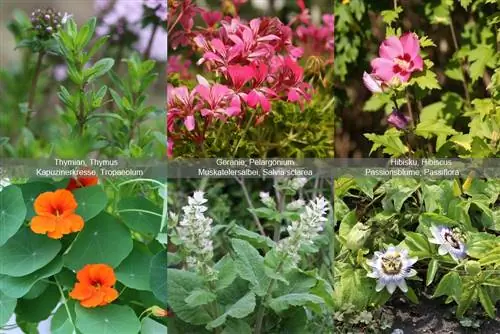
Conclusion
If you ban poisonous plants from your family's immediate surroundings, they will unfortunately not die out. If your cat is an outdoor animal, he will encounter poisonous plants outside - so you don't have to live in constant fear that your cat will come home foaming at the mouth. Cats are not small children who freely put EVERYTHING in their mouths (especially outside where there is no chance of boredom). However, this brings us to an important point: Keeping your household poison-free does not prevent you from teaching children how to deal with poisonous plants. However, the advantage remains that raising awareness of toxic substances is very relaxing, e.g. B. can be done when visiting a botanical garden - better than having to provide the information after a doctor's visit that would have saved that doctor's visit.

